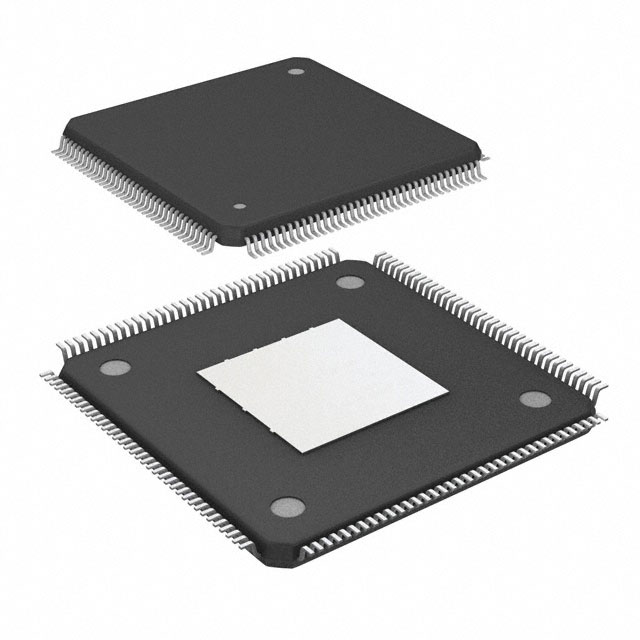EP4CE22E22C6
Product Overview
- Category: Programmable Logic Device (PLD)
- Use: EP4CE22E22C6 is a high-performance field-programmable gate array (FPGA) designed for various applications in the electronics industry.
- Characteristics: It offers advanced features such as high-speed performance, low power consumption, and flexibility in design implementation.
- Package: The EP4CE22E22C6 comes in a compact package suitable for surface mount technology (SMT) assembly.
- Essence: This FPGA provides a versatile platform for implementing complex digital logic circuits with programmable functionality.
- Packaging/Quantity: The EP4CE22E22C6 is typically sold in reels or trays, with each reel/tray containing a specific quantity of devices.
Specifications
- Logic Elements: The EP4CE22E22C6 consists of 22,320 logic elements, which can be configured to perform various functions.
- Memory: It includes 1,288 kilobits of embedded memory for storing data.
- Clock Management: The device incorporates advanced clock management circuitry, allowing precise control over clock signals.
- I/O Interfaces: EP4CE22E22C6 supports multiple I/O standards, including LVCMOS, LVTTL, and SSTL.
- Operating Voltage: It operates at a voltage range of 1.2V to 3.3V, making it compatible with a wide range of systems.
- Speed Grade: The EP4CE22E22C6 is available in different speed grades, offering varying levels of performance.
Detailed Pin Configuration
The EP4CE22E22C6 has a total of 484 pins, which are organized into different functional groups. The pin configuration includes dedicated input/output pins, clock pins, power supply pins, and configuration pins. A detailed pinout diagram can be found in the device's datasheet.
Functional Features
- High-Speed Performance: The EP4CE22E22C6 offers fast operation, making it suitable for applications that require real-time processing.
- Flexibility: With its programmable nature, this FPGA allows designers to implement custom logic functions and adapt to changing requirements.
- Low Power Consumption: The device incorporates power-saving features, enabling efficient utilization of energy resources.
- Reconfigurability: EP4CE22E22C6 can be reprogrammed multiple times, allowing for iterative design improvements and easy updates.
Advantages and Disadvantages
Advantages: - Versatile platform for implementing complex digital logic circuits - High-speed performance for real-time applications - Flexibility in design implementation - Low power consumption for energy-efficient operation - Reconfigurable for iterative design improvements
Disadvantages: - Steep learning curve for beginners due to the complexity of FPGA programming - Higher cost compared to traditional fixed-function integrated circuits - Limited availability of alternative models with similar specifications
Working Principles
The EP4CE22E22C6 operates based on the principles of field-programmable gate arrays. It consists of an array of configurable logic elements interconnected through programmable routing resources. These logic elements can be programmed to perform various functions, such as arithmetic operations, data storage, and control logic. The device's behavior is determined by the configuration data loaded into its internal memory.
Detailed Application Field Plans
The EP4CE22E22C6 finds applications in a wide range of fields, including:
- Communications: Used in wireless communication systems, network routers, and base stations.
- Industrial Automation: Employed in control systems, robotics, and factory automation.
- Automotive: Integrated into automotive electronics for functions like advanced driver assistance systems (ADAS) and infotainment.
- Aerospace: Utilized in avionics systems, satellite communication, and navigation equipment.
- Medical: Applied in medical imaging devices, patient monitoring systems, and laboratory equipment.
Detailed and Complete Alternative Models
While the EP4CE22E22C6 is a powerful FPGA, there are alternative models available with similar specifications. Some notable alternatives include:
- Xilinx Spartan-6 XC6SLX25
- Altera Cyclone IV EP4CE30F23
- Lattice ECP5-12K
- Microsemi SmartFusion2 M2S010
These alternative models offer comparable features and can be considered based on specific project requirements.
Word count: 550 words
Senaraikan 10 soalan dan jawapan biasa yang berkaitan dengan aplikasi EP4CE22E22C6 dalam penyelesaian teknikal
Sure! Here are 10 common questions and answers related to the application of EP4CE22E22C6 in technical solutions:
Q: What is EP4CE22E22C6? A: EP4CE22E22C6 is a specific model number of a field-programmable gate array (FPGA) manufactured by Intel (formerly Altera).
Q: What are the key features of EP4CE22E22C6? A: Some key features of EP4CE22E22C6 include 22,320 logic elements, 594 embedded memory blocks, 66 DSP blocks, and support for various I/O standards.
Q: How can EP4CE22E22C6 be used in technical solutions? A: EP4CE22E22C6 can be used in a wide range of applications such as digital signal processing, image and video processing, communication systems, industrial automation, and more.
Q: What programming languages can be used with EP4CE22E22C6? A: EP4CE22E22C6 can be programmed using hardware description languages (HDLs) like VHDL or Verilog, as well as high-level synthesis (HLS) tools.
Q: Can EP4CE22E22C6 be reprogrammed after deployment? A: Yes, EP4CE22E22C6 is a field-programmable device, which means it can be reprogrammed even after it has been deployed in a system.
Q: What development tools are available for working with EP4CE22E22C6? A: Intel Quartus Prime is the primary development tool for programming and configuring EP4CE22E22C6. It provides a complete design environment for FPGA development.
Q: What is the power consumption of EP4CE22E22C6? A: The power consumption of EP4CE22E22C6 depends on the specific design and usage scenario. It is recommended to refer to the device datasheet for detailed power specifications.
Q: Can EP4CE22E22C6 interface with other components or devices? A: Yes, EP4CE22E22C6 supports various I/O standards and can interface with other components or devices such as sensors, memory modules, communication interfaces, etc.
Q: Are there any limitations or constraints when using EP4CE22E22C6? A: EP4CE22E22C6 has certain limitations like finite resources (logic elements, memory blocks, etc.), timing constraints, and power considerations that need to be taken into account during design.
Q: Where can I find additional resources and support for EP4CE22E22C6? A: Intel provides documentation, application notes, reference designs, and a community forum where you can find additional resources and get support for EP4CE22E22C6.
Please note that the answers provided here are general and may vary depending on the specific requirements and use cases.


